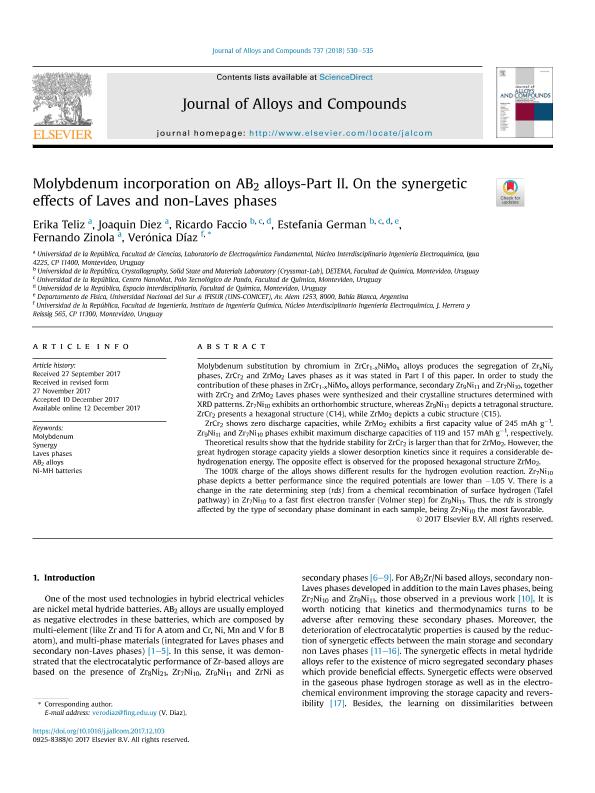Mostrar el registro sencillo del ítem
dc.contributor.author
Teliz, Erika
dc.contributor.author
Diez, Joaquín
dc.contributor.author
Faccio, Ricardo
dc.contributor.author
German, Estefania

dc.contributor.author
Zinola, Fernando
dc.contributor.author
Díaz, Verónica
dc.date.available
2019-11-04T18:25:08Z
dc.date.issued
2018-03-15
dc.identifier.citation
Teliz, Erika; Diez, Joaquín; Faccio, Ricardo; German, Estefania; Zinola, Fernando; et al.; Molybdenum incorporation on AB 2 alloys-Part II. On the synergetic effects of Laves and non-Laves phases; Elsevier Science Sa; Journal of Alloys and Compounds; 737; 15-3-2018; 530-535
dc.identifier.issn
0925-8388
dc.identifier.uri
http://hdl.handle.net/11336/87942
dc.description.abstract
Molybdenum substitution by chromium in ZrCr1-xNiMox alloys produces the segregation of ZrxNiy phases, ZrCr2 and ZrMo2 Laves phases as it was stated in Part I of this paper. In order to study the contribution of these phases in ZrCr1-xNiMox alloys performance, secondary Zr9Ni11 and Zr7Ni10, together with ZrCr2 and ZrMo2 Laves phases were synthesized and their crystalline structures determined with XRD patterns. Zr7Ni10 exhibits an orthorhombic structure, whereas Zr9Ni11 depicts a tetragonal structure. ZrCr2 presents a hexagonal structure (C14), while ZrMo2 depicts a cubic structure (C15). ZrCr2 shows zero discharge capacities, while ZrMo2 exhibits a first capacity value of 245 mAh g−1. Zr9Ni11 and Zr7Ni10 phases exhibit maximum discharge capacities of 119 and 157 mAh g−1, respectively. Theoretical results show that the hydride stability for ZrCr2 is larger than that for ZrMo2. However, the great hydrogen storage capacity yields a slower desorption kinetics since it requires a considerable de-hydrogenation energy. The opposite effect is observed for the proposed hexagonal structure ZrMo2. The 100% charge of the alloys shows different results for the hydrogen evolution reaction. Zr7Ni10 phase depicts a better performance since the required potentials are lower than −1.05 V. There is a change in the rate determining step (rds) from a chemical recombination of surface hydrogen (Tafel pathway) in Zr7Ni10 to a fast first electron transfer (Volmer step) for Zr9Ni11. Thus, the rds is strongly affected by the type of secondary phase dominant in each sample, being Zr7Ni10 the most favorable.
dc.format
application/pdf
dc.language.iso
eng
dc.publisher
Elsevier Science Sa

dc.rights
info:eu-repo/semantics/openAccess
dc.rights.uri
https://creativecommons.org/licenses/by-nc-sa/2.5/ar/
dc.subject
AB2 ALLOYS
dc.subject
LAVES PHASES
dc.subject
MOLYBDENUM
dc.subject
NI-MH BATTERIES
dc.subject
SYNERGY
dc.subject.classification
Física de los Materiales Condensados

dc.subject.classification
Ciencias Físicas

dc.subject.classification
CIENCIAS NATURALES Y EXACTAS

dc.title
Molybdenum incorporation on AB 2 alloys-Part II. On the synergetic effects of Laves and non-Laves phases
dc.type
info:eu-repo/semantics/article
dc.type
info:ar-repo/semantics/artículo
dc.type
info:eu-repo/semantics/publishedVersion
dc.date.updated
2019-10-15T17:27:46Z
dc.journal.volume
737
dc.journal.pagination
530-535
dc.journal.pais
Países Bajos

dc.journal.ciudad
Amsterdam
dc.description.fil
Fil: Teliz, Erika. Universidad de la República; Uruguay
dc.description.fil
Fil: Diez, Joaquín. Universidad de la República; Uruguay
dc.description.fil
Fil: Faccio, Ricardo. Universidad de la República; Uruguay
dc.description.fil
Fil: German, Estefania. Universidad de la República; Uruguay. Consejo Nacional de Investigaciones Científicas y Técnicas. Centro Científico Tecnológico Conicet - Bahía Blanca. Instituto de Física del Sur. Universidad Nacional del Sur. Departamento de Física. Instituto de Física del Sur; Argentina
dc.description.fil
Fil: Zinola, Fernando. Universidad de la República; Uruguay
dc.description.fil
Fil: Díaz, Verónica. Universidad de la República; Uruguay
dc.journal.title
Journal of Alloys and Compounds

dc.relation.alternativeid
info:eu-repo/semantics/altIdentifier/url/https://www.sciencedirect.com/science/article/pii/S092583881734286X
dc.relation.alternativeid
info:eu-repo/semantics/altIdentifier/doi/http://dx.doi.org/10.1016/j.jallcom.2017.12.103
Archivos asociados
